
The United Nations On Monday (06.19.23) a “crucial” agreement was adopted to protect vast areas of key marine ecosystems. Environmentalists welcome the deal because it could prevent the loss of marine biodiversity Promote sustainable development.
“He High Seas Treaty“Essential for the protection of the oceans,” Rebecca Hubbard, director of the Altamar Alliance, which works with more than 50 non-governmental organizations to strengthen sustainable ocean governance, told DW. Don’t just think about marine animals. “It’s also important for climate protection and the livelihoods of billions of people around the world,” says Hubbard.
Between April and May this year, scientists reported the highest global sea surface temperatures since records began in 1850. Oceans absorb 90 percent of the heat generated by the emission of greenhouse gases, which continue to warm the planet. Oceans are “the world’s greatest ally in the fight against climate change” and produce 50 percent of Earth’s oxygen.
There are still many issues to be resolved
To enter into force, the binding agreement must be signed and ratified by at least 60 states. But adoption alone represents a major turning point for the conservation of the high seas and all marine life. The agreement is expected to contribute to the conservation and sustainable use of marine resources while protecting the rights and interests of all countries involved.
When it comes to nature conservation, large areas of the ocean are a kind of “no man’s land”: fishing, shipping, tourism and marine conservation are regulated by about 20 organizations around the world. However, these rules apply only up to 200 nautical miles from the coast. From there, no national law was valid and no action was taken by the states.
Although the high seas cover more than half of the Earth’s surface and 61 percent of all oceans, only 1 percent of international waters are protected.
The potential for new protected areas in the high seas
The agreement creates the legal framework that allows for the establishment of marine protected areas. However, many questions remain to be resolved, such as where and when these protected areas will be established and how exactly remote marine areas far from shore will be protected. “Once the states ratify the agreement, the work can begin,” says Rebecca Hubbard. But this must happen as soon as possible to prevent extinction of species in the sea.
In June 2025, the UN Convention on the Law of the Sea The goal is to have the High Seas Convention ratified by countries before the conference. It might be too fast, but according to Hubbard it’s possible and necessary.
How to immediately protect marine ecosystems
UNESCO estimates that half of marine species are at risk of extinction by the end of this century unless fundamental changes are made. This does not mean that we should stop using the ocean, but rather that it should be used in a way that does not harm it in the best possible way, or at least so that it can recover on its own.
Currently, 80 percent of the world’s wastewater continues to be discharged untreated into the ocean, and the figure reaches 95 percent in the poorest countries. This waste water pollutes and destroys water bodies and coastal areas. The establishment of sustainable wastewater systems, especially in developing countries, not only contributes to the protection of the marine ecosystem, but also to the improvement of drinking water supply in many places.
(gg/ers)

“Introvert. Thinker. Problem solver. Evil beer specialist. Prone to fits of apathy. Social media expert. Award-winning food fanatic.”





More Stories
Two influencers drown after refusing to wear life jackets: “ruining selfies”
Uruguay 2024 election results: who won and when is the second round | Waiting to know whether there will be a runoff or not
Uruguay: Lacalle Pou leaves with his figure on the slopes | The Marcet and Asteziano scandals hit the right-wing ruler